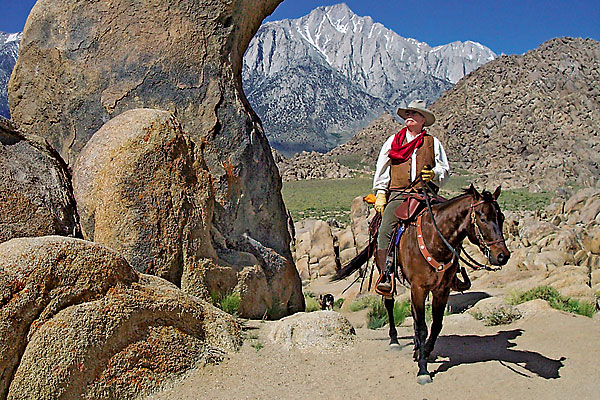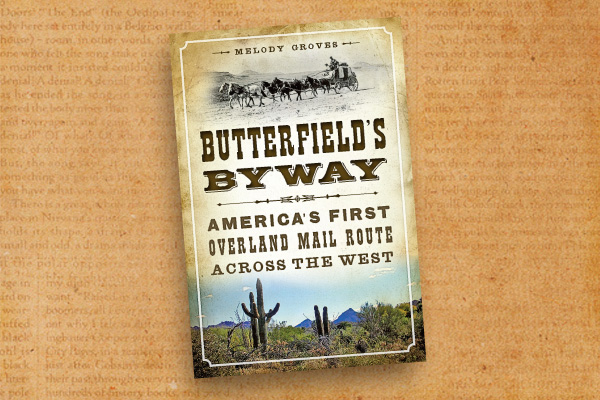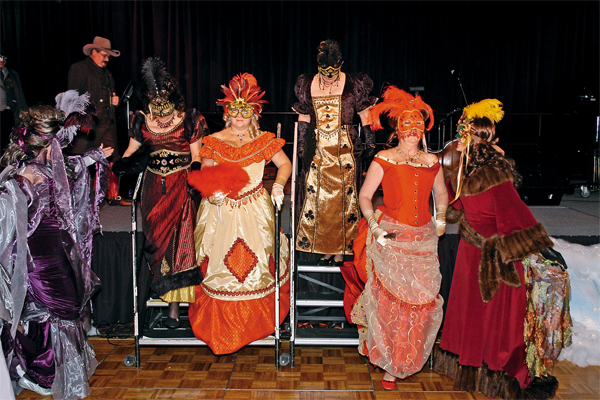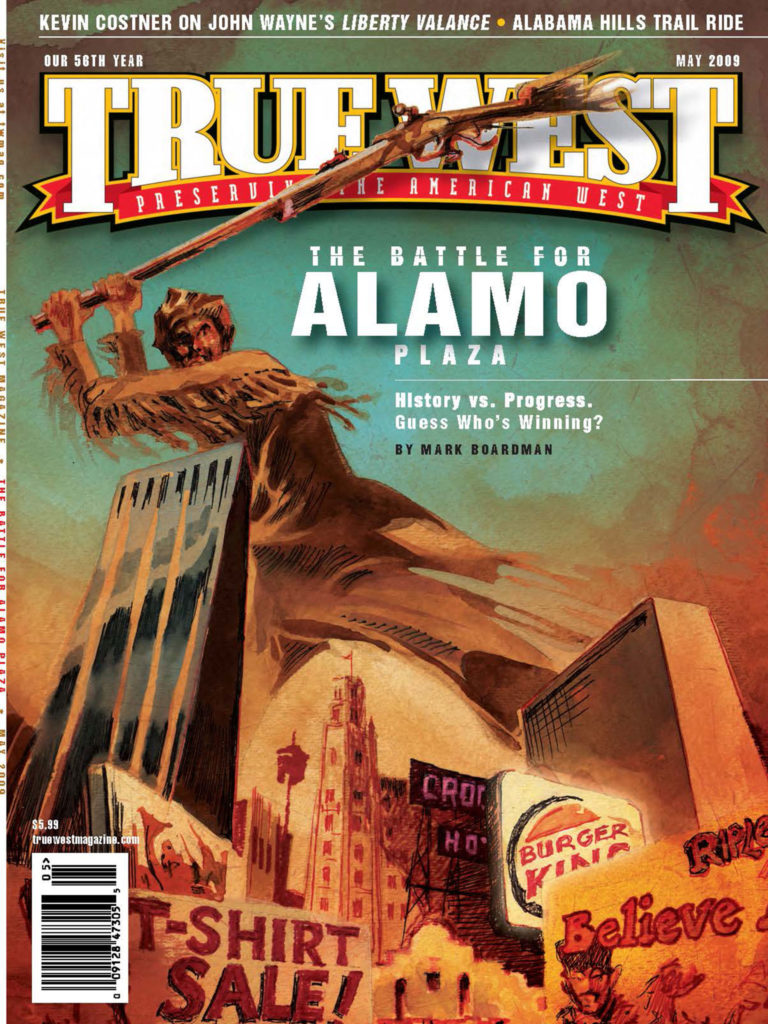
My wife Dana and I rode into the heart of the Alabama Hills, a place I had been to thousands of times in my 50-plus years, even though I’d never set foot here before.
Situated west of Lone Pine, California, in the beautiful but stark Owens Valley, the Alabama Hills have been the setting for more than 350 movies, TV shows and commercials—many, many of them Westerns. Since 1920, when Fatty Arbuckle starred in The Round Up, the Hills helped define the image of the West. Its rounded, bouldery-shaped mounds of weathered granite formations were perfect for staging ambushes, hiding out from the law, holing up in a sandstorm or mining for gold.
Towering mountains also play a role in the mythos of the West. Whether used as a backdrop for westward migration, a barrier to be overcome in a howling snowstorm, rich timberlands to pillage or great pasturelands filled with cattle, the mighty Sierras, which soar over the Alabamas, are ever-present in hundreds of Westerns.
And what Western worth its salt was without a barren desert crossing? The dry lakebed of Owens Lake is custom-made to substitute for Death Valley (just over the Panamint Range), the Mojave Desert or anywhere else that called for a scene of utter emptiness.
Besides passing for all the Western states, the region around the Hills has stood in for distant lands as well—Kyber Pass in India, Old Mexico, Peru, Argentina, even outer space! Only about 200 miles from Hollywood, the sleepy town of Lone Pine offered the director a palette as big as all the outdoors, as weird as another planet or as desolate as the ends of the earth.
Trail History
The rounded boulders just west of town got their name in 1864 from prospectors during the great War Between the States. These men, Southern sympathizers, wanted to celebrate the victories of the Confederate cruiser, The Alabama, which caused some $60 million worth of damage to 60 Union vessels. The moniker for their placer mines was soon applied to the entire region of rocky outcroppings. Signs of mining still dot the area, mostly on the north end of the rocks.
The town itself was named for a solitary tree that grew at the mouth of Lone Pine Canyon in the mid-1800s. It was first a supply depot for miners. Civilization followed the argonauts, and farmers and merchants settled the place. The arrival of the Carson Colorado Railroad provided a permanent link with the outside world. Lone Pine was nearly leveled on March 26, 1872, during an earthquake, with an estimated Richter magnitude of 7.6 to 8, similar in intensity to that of the great San Francisco quake. Twenty-seven of approximately 250 residents died as the town’s many adobe buildings crumbled.
Lone Pine today is known as the “Gateway to Mt. Whitney,” which, at 14,405 feet above sea level, is the highest point in the lower 48 states. The Whitney Portal Road passes right by the Alabama Hills and ends at a campground and trailhead that leads to the famous peak.
A Hoppy Vacation
My interest on this trip was not high up in the lofty Sierras, but down on the flats where movie magic has been made for so many years. I am a long-time, avid collector of Western films, but it wasn’t until I watched the Hopalong Cassidy series of films on Encore’s Westerns Channel that I marveled at the stunning backdrops used in his films. I had to find out where these Hoppys were filmed and haul my ponies down there.
Lone Pine, California, kept popping up in the credits. After months of waiting out winter, I visited this mecca of Western film locations. I picked up a copy of Dave Holland’s book, On Location in Lone Pine, loaded the ponies and headed south, from my family’s ranchette near Bend, Oregon, to the Owens Valley.
Once my wife and I arrived, we weren’t settling for a driving tour of the movie locations; that’s only scratching the surface. The best way to see the place is to get out of your vehicle and ride out among the rocks and crags on horseback.
Slow down a bit to savor this fabulous locale at a slow walk, or else you’re going to trailer back home disappointed. It takes less than an hour to horseback ride in a straight line from Ruiz Rocks to the Mobius Arch and back on Movie Flats Road. Where’s the fun in that?
Instead, take the time to find and ride through the Lone Ranger ambush canyon and hear the roar of gunfire again. Gallop down Movie Flats Road with Yakima Canutt and hold your breath as he performs his famous under-the-wagon stunt. Hide with Hopalong Cassidy and California Carlson as they dodge the bad guys at the Hoppy Rocks. Pause with Gene Autry, Smiley Burnette and young Ronald Sinclair under a monolith now known as Gene Autry Rock.
You’ll need at least three or four days of riding to cover most of the nooks and crannies in this labyrinth of wild and twisted boulders. Even weeks of riding will lead you to merely a portion of the movie locations. Your memories of John Wayne, Tom Mix, Hoot Gibson, Errol Flynn, Gary Cooper, Dale Evans, Robert Mitchum, Roy Rogers, Jack Elam, Randolph Scott and Clint Eastwood will ride with you as you wind your way through the rocks under a blazing sun.
The lands here are managed primarily by the Bureau of Land Management. Most anything you can do on BLM land, you can do here as well, including camping out among the Alabama Hills. By May, temperatures can soar to the 80s, but only the high 90 to low 100-degree temperatures during July and August preclude much horseback activity. It was 105 degrees during my trip in late spring, but luckily, we discovered the one and only grove of shade trees on public land in the neighborhood where we could string a highline for the horses’ comfort. (The trees are easy to spot on the south side of the Whitney Portal Road, just past Horseshoe Meadows Road.) Be prepared, as no forage is available and water from Lone Pine Creek is hard to access due to the steep creek bed and thick underbrush. Please practice “Leave No Trace” camping techniques to help ensure future horse use in the area.
For riders looking for cushier digs, the De La Cour Ranch is five miles south of the Alabama Hills on Horseshoe Meadow Road and offers two cabins with full kitchens, as well as outdoor barbecues. Group tenting sites for camping are also available. The ponies can be housed in pipe corrals and a barn with four stalls with outdoor runs.
If you have ever wanted to experience the Reel West and ride in the hoofprints of Hoppy, Gene and Roy, saddle up your own time machine and take the back trail to the Alabama Hills.





